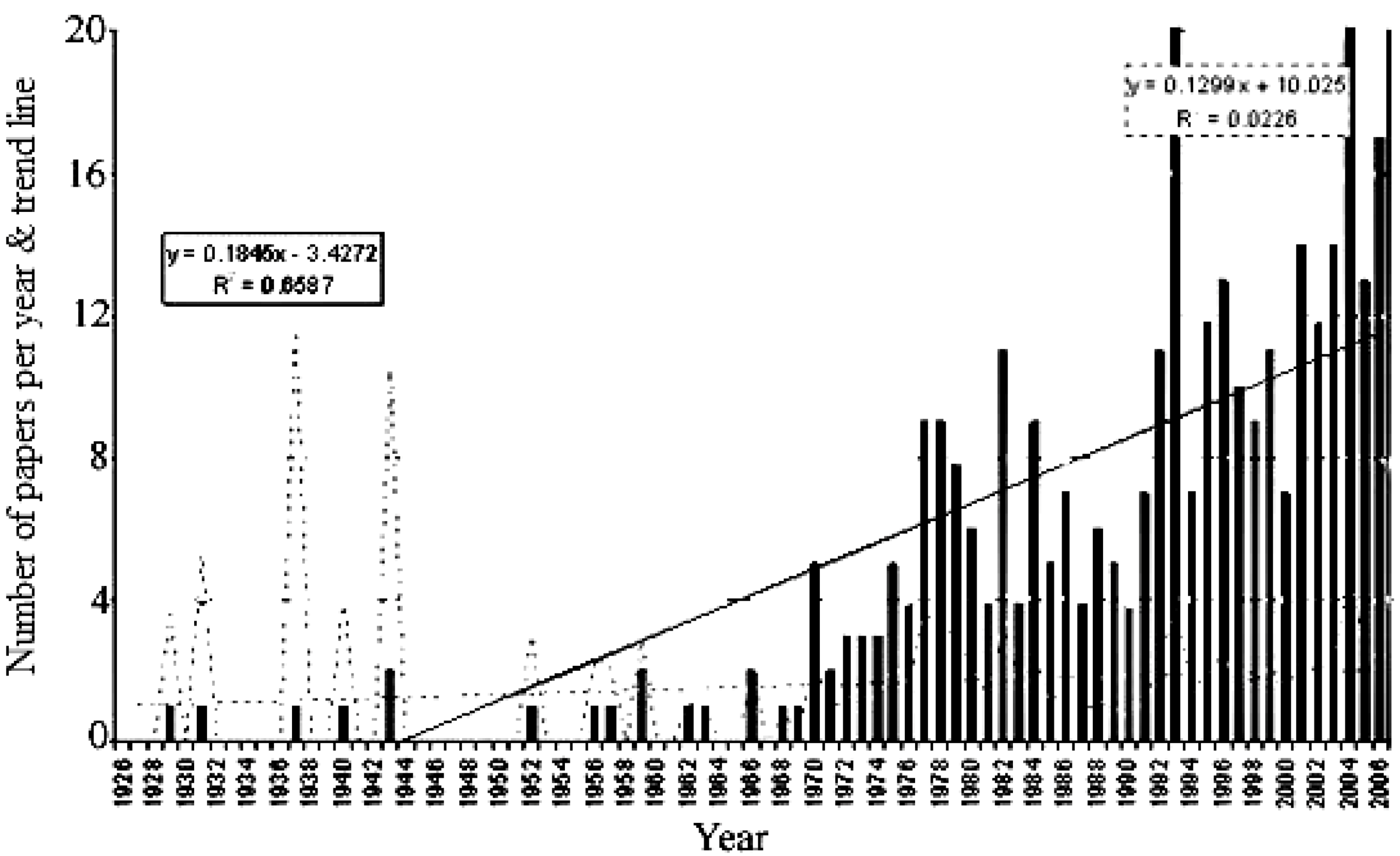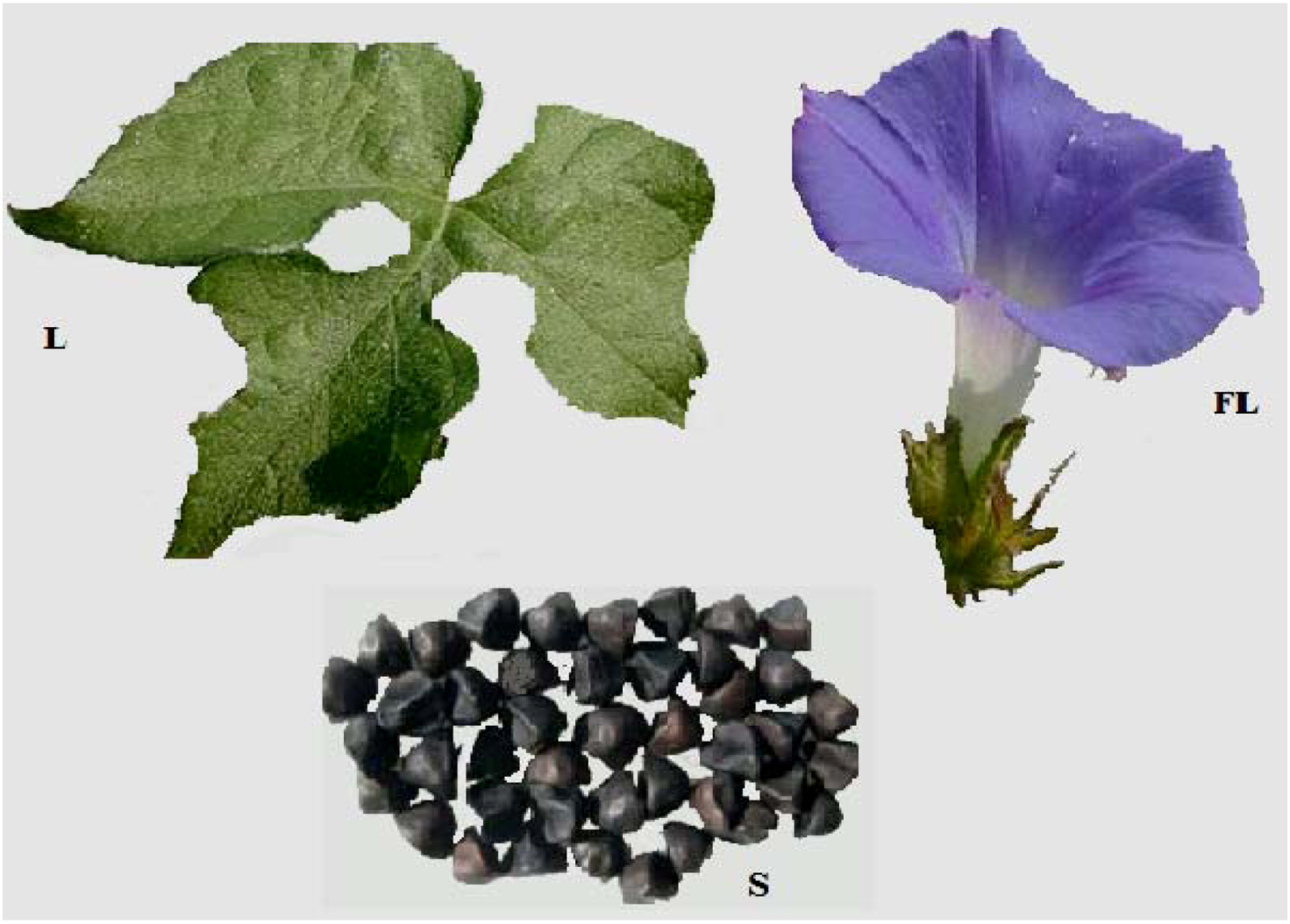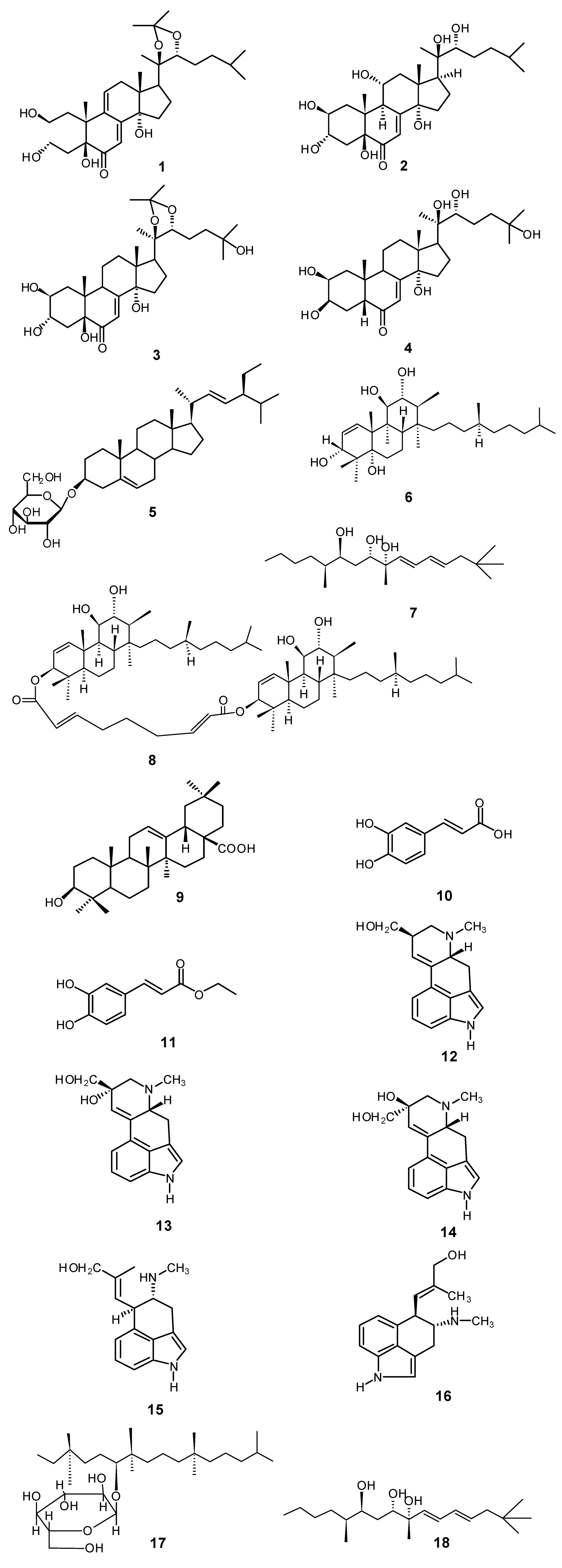1. Introduction
Plants are old friends of humans who rely on plants directly or indirectly for food, shelter, aesthetic purposes and for the treatment of diseases. Plants can considered as biological factories for the production of various medicinal compounds. Hence plants enjoy the attraction of common man as well as of the scientific community for investigation, authentication and rationalization of their food and therapeutic effects. As a part of our continuous efforts to explore the medicinal flora of Pakistan [
1,
2,
3] we focused on a member of the family
Convolvulaceae that comprises nearly 1,650 predominantly tropical species. The genus
Ipomoea, with approximately 500–600 species, is the largest in the family [
4] and twenty species are found in Pakistan [
5]. Plants of this genus have been in continuous use since immemorial time for different nutritional, medicinal, ritual and agricultural purposes. Various species of
Ipomoea have been extensively used in local traditional medicine in many countries for the treatment of several diseases [
6].
Ipomoea hederacea Jacq. is known in the flora of Pakistan not only for its medicinal and therapeutic attributes (
Figure 1), but it is frequently grown in gardens for its ornamental flowers and often runs wild in hedges and wastelands [
7,
8,
9,
10]. In light of its phytochemical, medicinal and therapeutic importance, this review focuses on its botanical description, traditional uses, phytochemical studies, toxicological and pharmacological aspects.
Figure 1.
Popularity of
Ipomea hederacea over time [
11].
Figure 1.
Popularity of
Ipomea hederacea over time [
11].
3. Phytochemistry
I. hederacea contains a greater amount (15.78%) of crude resin than
I. muricata Jacq (10.6%). Similarly the saponification number of the crude resin of
I. hederacea was also greater (144.7) than that of
I. muricata (116.7), while the acid numbers of both are fairly uniform [
34]. Kathpalia and co-workers analyzed the seeds of
I. hederacea and reported a fixed oil content of 9.38% with d
20 = 0.918, n
20 = 1.474, viscosity at 20° = 0.2938, saponification no. = 190.48, acetyl no. = 5.19, acid no. = 3.45, I. no. = 121.5, unsaponifiable = 1.98%; the mixed fat acids fraction had a neutralization value of 190.90, I no. 126.5 [
35]. Seeds contain 4%–15% crude resinous matter; a fixed oil (12.4%) and small amount of saponins, mucilage and tannins [
36]. Ahmad and co-workers confirmed the presence of saponins, tannins, terpenes, alkaloids and proteins in an ethanolic extract of seeds [
37]. Alkaloids, reducing sugars, terpenoids, flavonoids, saponins and tannins were also reported [
16]. The seed oil of
I. hederacea was evaluated for color, refractive index, acid value, saponification value and unsaponifiable matter by standard IUPAC methods for the analysis of oils (
Table 1) [
38].
Table 1.
Physico-chemical parameters of the seed oil of I. hederacea.
Table 1.
Physico-chemical parameters of the seed oil of I. hederacea.
| Parameter | Property/Content |
|---|
| Color | Light yellow |
| Refractive index | 1.47 |
| Specific gravity | 0.92 |
| Unsaponifiable matter | 1.73 |
| Acid value | 2.98 |
| Saponification value | 190.48 |
Phytochemical studies on
I. hederacea have been conducted since the mid 1960s and one of the early studies reported the isolation of the alkaloids lysergol, chanoclavine, penniclavine, isopeniclavine and elymoclavine from seeds. Chanoclavine, elymoclavine, lysergol and penniclavine were known to be psychoactive [
36]. Isopenniclavine was reported to be psychotomimetic, while penniclavine, lysergol and elymoclavine were reported to be psychotropic [
6]. Ahmad and co-workers reported the presence of tiglic acid, methyl ethyl acetic acid and α-methyl-β-oxybutyric acid in an ether soluble portion of a glycosidal fraction in the resin of
I. hederacea seeds and the presence of pharbitinic acid, phytoecdysone, a plytosteratin, lysergol and chanoclavine [
7]. Five ecdysteriods, two steroidal glycosides, one triterpene and two aromatic acids have also been isolated. Among ecdysteriods, hederasterone A, hederasterone A-20,22 monoacetonide and hedersterone B were reported for the first time from this plant [
18]. Other reported compounds were 20-hydroxyecdysone, stigmasterol 3-O-β-
D-glucoside, β-sitosterol-3-
O-β-
D-glucoside, oleanolic acid, caffeic acid, ethylcaffeate. In a butyryl-cholinesterase enzyme inhibitory assay, only hedersterone B exhibited inhibition and caffeic acid and ethylcaffeate showed antioxidant and lipoxygenase inhibition activity [
18]. The most recent phytochemical investigation of the seeds of
I. hederacea resulted in the isolation of hederaceterpenol, hederacetriol, hederaterpenoside, hederacyl triterpenoid and stigmast-5-en-3-
O-β-
D-glucopyranoside [
7] (
Figure 3). Compositional studies of
I. hederacea seed and seed oil have been carried out by Kathpalia and Dutt [
35] and later by Zia-Ul-Haq and co-workers [
38]. (
Table 2,
Table 3,
Table 4,
Table 5,
Table 6,
Table 7). According to these studies, the proximate chemical composition (
Table 2), the percent composition of amino acids in seeds (
Table 3), their mineral content (
Table 4), the percent composition of the oil (
Table 5) the fatty acid (
Table 6) and the tocopherol profiles (
Table 7) indicated that the plant oil can be considered a substantial source of essential nutrients and may be used as food once its toxicity profile is established.
Figure 3.
Phytochemicals isolated from I. hederacea: hederasterone A-20,22-monoacetonide (1), hedrasterone B (2), 20-hydroxyecdysone-20,22-monoacetonide (3), 20-hydroxyecdysone (4), stigmasterol-3-o-β-D-glucoside (5), hederaceterpenol (6), oleanolic acid (7), caffeic acid (8), ethyl caffeate (9), lysergol (10), penniclavine (11), hederacetriol (12), isopenniclavine (13), chanoclavine (14), hanoclavine (15), elymoclavine (16), hederaterpenoside (17), hederacyl triterpenoid (18).
Figure 3.
Phytochemicals isolated from I. hederacea: hederasterone A-20,22-monoacetonide (1), hedrasterone B (2), 20-hydroxyecdysone-20,22-monoacetonide (3), 20-hydroxyecdysone (4), stigmasterol-3-o-β-D-glucoside (5), hederaceterpenol (6), oleanolic acid (7), caffeic acid (8), ethyl caffeate (9), lysergol (10), penniclavine (11), hederacetriol (12), isopenniclavine (13), chanoclavine (14), hanoclavine (15), elymoclavine (16), hederaterpenoside (17), hederacyl triterpenoid (18).
Table 2.
Percent proximate composition of I. hederacea seeds.
Table 2.
Percent proximate composition of I. hederacea seeds.
| Component | Content |
|---|
| Crude protein | 23.36 |
| Total lipids | 14.09 |
| Total carbohydrates | 37.06 |
| Crude fiber | 16.55 |
| Moisture | 5.29 |
| Ash | 3.65 |
Table 3.
Percent composition of amino acids in I. hederacea seeds.
Table 3.
Percent composition of amino acids in I. hederacea seeds.
| Amino acid | Content |
|---|
| Isoleucine | 5.03 |
| Leucine | 6.59 |
| Lysine | 4.25 |
| Methionine | 1.17 |
| Phenylaniline | 6.24 |
| Threonine | 3.07 |
| Tryptophan | 1.88 |
| Valine | 7.10 |
| Arginine | 5.50 |
| Histidine | 3.55 |
| Alanine | 3.99 |
| Aspartic acid | 10.82 |
| Cystine | 0.90 |
| Glutamic acid | 22.71 |
| Glycine | 5. 36 |
| Proline | 4.46 |
| Serine | 4.02 |
| Tyrosine | 2.58 |
Table 4.
Mineral content (mg/100 g) of I. hederacea seeds.
Table 4.
Mineral content (mg/100 g) of I. hederacea seeds.
| Metals | Content |
|---|
| Calcium | 317.41 |
| Copper | 4.62 |
| Iron | 9.85 |
| Magnesium | 179.14 |
| Manganese | 6.37 |
| Phosphorus | 596.19 |
| Potassium | 978.46 |
| Sodium | 106.32 |
| Zinc | 4.01 |
| Na:K | 0.11 |
| Ca:P | 0.53 |
Table 5.
Percent composition of I. hederacea seed oil.
Table 5.
Percent composition of I. hederacea seed oil.
| Oil class | Composition |
|---|
| Hydrocarbons + waxes | 0.40 |
| Steryl esters | 0.60 |
| Triacylglycerols | 80.20 |
| Free fatty acid | 1.20 |
| Diglycerols | 0.70 |
| Monoglycerols | 1.00 |
| Polar lipids | 6.50 |
| Phospholipids | 4.80 |
| Unidentified | 4.60 |
Table 6.
Fatty acid profile (%) of I. hederacea seed oil.
Table 6.
Fatty acid profile (%) of I. hederacea seed oil.
| Fatty acid | Ipomoea hederacea [38] | Ipomoea hederacea [35] |
|---|
| Palmitic acid (16:0) | 17.03 | 5.93 |
| Palmitoleic acid (16:1) | 1.10 | - |
| Stearic acid (18:0) | 6.00 | 20.37 |
| Oleic acid (18:1) | 19.50 | 43.98 |
| Linoleic acid (18:2) | 52.09 | 14.54 |
| α-Linolenic acid (18:3) | 4.28 | 5.99 |
| Arachidic acid (20:0) | - | 7.79 |
| Eicosaenoic acid (20:1) | - | - |
| Behenic acid | - | 1.29 |
Table 7.
Tocopherol profile (mg/100g) of I. hederacea seed oil.
Table 7.
Tocopherol profile (mg/100g) of I. hederacea seed oil.
| Tocopherol | Ipomoea hederacea |
|---|
| α-Tocopherol | 0.50 |
| β-Tocopherol | 1.60 |
| γ-Tocopherol | 28.70 |
| δ-Tocopherol | 2.30 |
| Total | 33.10 |
Various phenols like erulic acid, coumaric acid-hexoside, ferulic acid-hexoside and sinapic acid-hexoside were tentatively identified in
I. hederacea seeds, based on their mass spectral characteristics [
38].










